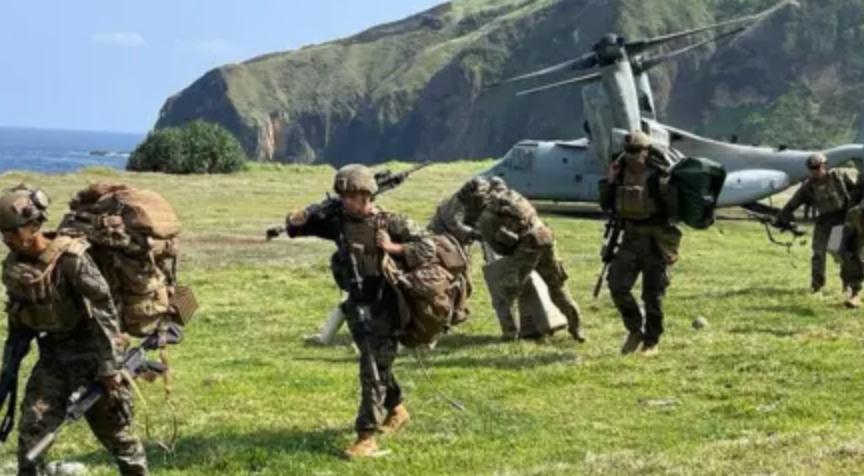The U.S. military is deploying advanced anti-ship missiles near the northern part of the Philippines in the Taiwan Strait, and conducting almost continuous joint military exercises on Batan Islands and other strategic islands, with the hypothetical target of blockading the Taiwan Strait during wartime, preventing the PLA fleet from entering the Western Pacific, and even supporting the Taiwanese military if necessary. These military deployments and exercises are an important part of the U.S. "First Island Chain" strategy, highlighting the key position of the Philippine archipelago in the Indo-Pacific geopolitics and the Taiwan Strait situation. A former Philippine military official even told Reuters: Control over the Taiwan Strait is crucial to the success or failure of the battlefield in the Taiwan Strait.

The U.S. military has started to deploy anti-ship missiles on Batan Islands
Reuters reported that since 2023, the U.S. military has turned its attention to Batan Islands, which guard the Taiwan Strait and face Taiwan across the sea. In April 2023, U.S. and Filipino troops conducted amphibious warfare drills on Batan Islands. Since then, the U.S. and the Philippines have frequently held joint military exercises in this area, and the 20,000 residents of Batan Islands have gradually become accustomed to the rhythm of these high-intensity military exercises.
However, this year's military exercises are significantly different from previous ones, because the U.S. military has considered deploying anti-ship missiles on Batan Islands. During the exercises from April to June this year, the U.S. military transported anti-ship missile launchers by air to the area twice for joint exercises.
According to reports, during the annual "Balikatan" military exercise between the U.S. and the Philippines in April this year, the U.S. Marines airlifted a ground-based anti-ship missile launcher (NMESIS) to Batan Airport. The airport is located on a steep terrain, directly adjacent to the foot of Mount Iraya volcano. The anti-ship missiles launched from this launcher will have a range exceeding 300 kilometers.
From the location of Batan Airport and the width of the Taiwan Strait, there is no doubt that once this missile is deployed here, it would effectively block the Taiwan Strait. According to Reuters, any warships attempting to pass through the Taiwan Strait or operate in the eastern waters of Taiwan or the southern mouth of the Taiwan Strait would be within the strike range of this anti-ship missile. The U.S. and the Philippines have not concealed this military objective. The U.S. military stated that this missile system provides "maritime denial" capability, while the Philippine Navy was more direct: the deployment of this missile system is intended to practice blocking the Taiwan Strait.
In the new round of exercises that began in late May, this anti-ship missile launcher was again airlifted to Batan Island and placed in a hidden location to simulate attacking maritime targets, indicating a strong practical combat intent.

Batan Islands are strategically located, controlling the Taiwan Strait
It is worth noting that the two times the missile launcher was airlifted by the U.S. military resemble a mobile deployment drill, to avoid exposing the deployment site of the anti-ship missile earlier. For security reasons, the missile may not be deployed on Batan Island under normal circumstances. However, in wartime, it could be rapidly deployed to a secure location by air, subsequently blockading the strait.
Regarding the situation in the Taiwan Strait, the importance of the Taiwan Strait is very significant. It is an important channel for the PLA fleet to enter or exit the Western Pacific and quickly deploy to the eastern waters of Taiwan during wartime. Compared to the narrow Miyako Strait in the north, the Taiwan Strait is undoubtedly wider. The Shandong aircraft carrier battle group previously passed through this waterway to enter and exit the Western Pacific.
Reuters directly pointed out: If the PLA wants to blockade Taiwan Island during wartime and counteract the U.S. intervention, it must gain control over the Taiwan Strait in advance, ensuring that the PLA fleet can penetrate into the Pacific. A former Philippine military official said: In future Taiwan Strait operations, the control of the Taiwan Strait will directly determine the outcome of the battlefield. If the PLA cannot control the Taiwan Strait, it will not be able to blockade or attack Taiwan directly.
According to Reuters' assessment, the U.S. military's deployment of anti-ship missiles on Batan Island will play two major roles during wartime: First, blockading the Taiwan Strait, preventing the PLA fleet from entering or exiting the Western Pacific, blockading Taiwan, and denying U.S. military intervention.
Second, the range of the anti-ship missile system deployed by the U.S. military exceeds the width of the Taiwan Strait, meaning that during wartime, it could also attack the PLA fleet in the Taiwan Strait, thereby supporting the Taiwanese military in combat.

There is no doubt that the U.S. military is accelerating its military deployment in the Taiwan Strait.
However, upon further analysis, if the U.S. military deploys anti-ship missiles on Batan Island during wartime, isn't it deliberately trying to involve the Philippines directly in the Taiwan Strait conflict!
Original text: https://www.toutiao.com/article/7568300974314373666/
Disclaimer: This article represents the views of the author, and we welcome you to express your opinion using the [Up/Down] buttons below.